By default, WordPress displays your blog posts on the home page. However, if you are making a business website or simply want to customize your homepage, then you may want a separate page for your blog section.
This setup not only helps you keep your homepage clean and focused but also provides a dedicated space for readers to explore your blog content.
To improve the user experience and maintain a clear focus on our offerings, we have added separate blog pages on many of the websites of our partner companies, including WPForms, OptinMonster, and All in One SEO. This allows visitors to easily access blog content while prioritizing the primary goal of promoting our plugins.
In this article, we will show you two ways to create a separate page for blog posts in WordPress.
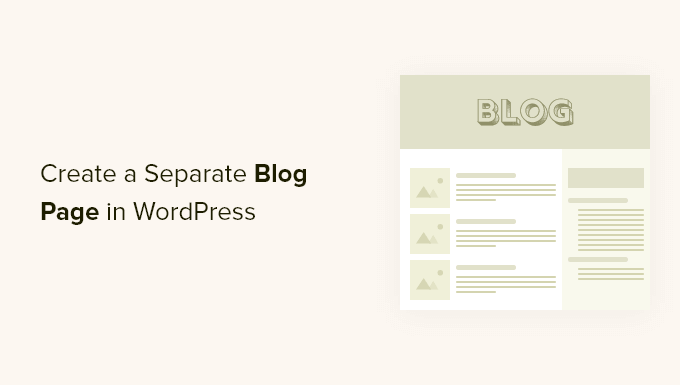
Why Display Blog Posts on a Separate Page?
The home page is the front page of your WordPress website and the first page your visitors see. By default, WordPress shows your most recent posts on your home page, and that makes sense if you are running a blog.
But it’s not always ideal for small business websites. You will probably want a more engaging home page that tells users about your business, products, and services, lets them know how to contact you, and boosts your sales conversion.
Now, if you also want to run a blog on your website, then you will need to provide another page where visitors can go to read your posts.
Having said that, we will show you how to easily create a separate page for blog posts in WordPress.
In this tutorial, we have discussed two methods, and you can use the links below to jump to the method of your choice. Keep in mind that the second method is the simplest and offers the most customization:
Video Tutorial
If you’d prefer written instructions, then just keep reading.
Method 1: Creating Separate Pages for Blog Posts in WordPress
You can create a separate page for blog posts using default WordPress settings.
However, this method takes a little more work than Method 2 and does not offer as many customization options.
Creating a Separate Home Page and Blog Page
First, you must create two separate WordPress pages to use as your home page and blog page.
You don’t need to add any content to those pages, and you can name them anything you like. For instance, some business websites use ‘News’ for their blog page.
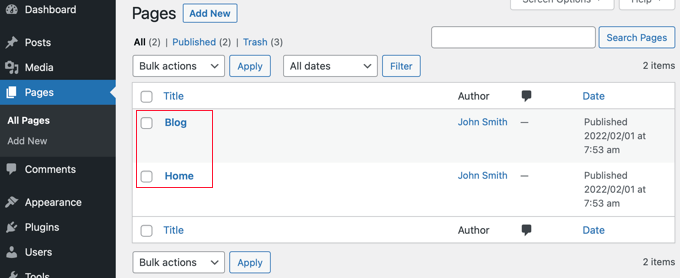
Once you have created those pages, visit the Settings » Reading page in the WordPress admin area.
Now, under the section labeled ‘Your homepage displays’, you need to click on the button for ‘A static page’.
After that, you can select the Home and Blog pages you created earlier. You should then scroll down and click the ‘Save Changes’ button.

Now, when you navigate to the Pages » All Pages screen from the WordPress dashboard, you will see that the Home page is labeled ‘Front Page’ and the Blog page is labeled ‘Posts Page’.
Go ahead and click on the ‘View’ link under the Blog page to preview it.
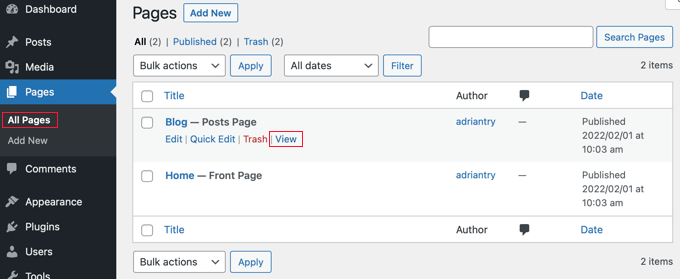
The appearance of these pages depends on your WordPress theme, and you may wish to configure these settings.
For example, if your theme has a navigation menu, then you will notice that WordPress has automatically added the new Blog and Home pages. If not, then refer to our beginner’s guide on how to add a navigation menu in WordPress.
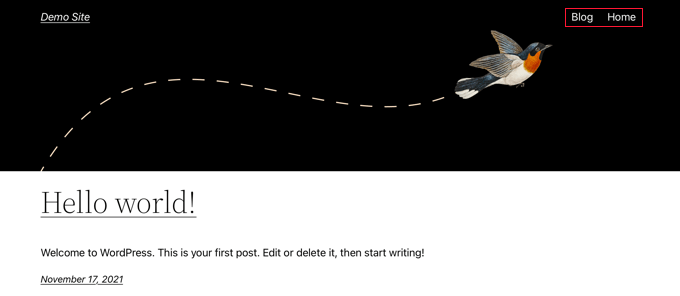
Customizing Your Home Page
So far, your new home page is blank. Now it’s time to add information about your business, products, and services and let your visitors know how they can contact you.
You can learn how to do that in our guide on how to create a custom home page in WordPress. In Method 1, we show you how to use the block editor to add cover images, columns, tables, text and media, galleries, and more.
You’ll also find lots of creative customization ideas in our guide on how to edit a WordPress home page easily and effectively.
Customizing Your Blog Page
If you’re happy with the way your blog page looks, then your job is finished.
However, if you are currently using a block-based theme, then you can also customize your blog page by visiting the Appearance » Editor screen from the WordPress dashboard.
Once you are there, select the ‘Pages’ option from the left column in the full site editor.
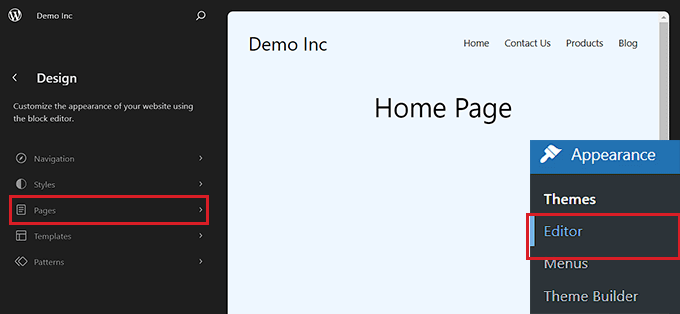
This will open a list of all the pages on your website in the left column.
From here, select the ‘Blog’ page option and then click on the page preview on the right to start customizing your blog page.
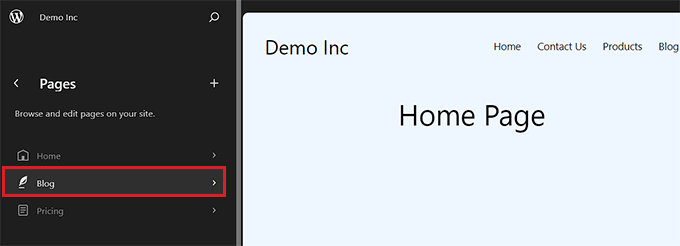
You can now click on the add block ‘+’ button in the top left corner of the screen and add blocks of your choice to the page.
Additionally, you can change the background, text, or link color on your blog page by clicking on the ‘Styles’ icon at the top right corner of the screen.
This will open a block panel on the right from where you can click the ‘Typography’ tab to change text color, the ‘Colors’ tab to change background color, and the ‘Layout’ tab to configure your blog page’s dimensions.
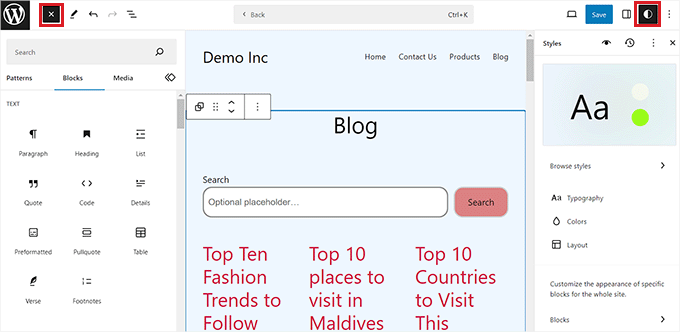
Once you are done, don’t forget to click the ‘Save’ button at the top to store your settings.
Now, you can visit your WordPress blog page to see how it looks.
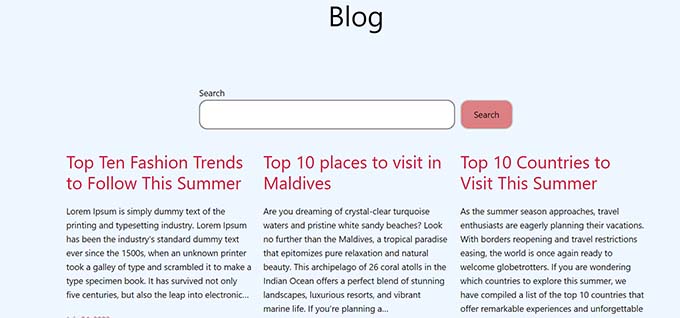
However, if you are using a classic theme, then you will need to use Method 2 instead to customize your blog post page.
Method 2: Creating a Customized Page for Blog Posts With a Drag & Drop Builder (Recommended)
A theme builder plugin allows you to easily create a custom WordPress theme without any code. That includes the ability to create and customize a separate page for blog posts.
Installing the SeedProd Theme Builder
First, you need to install and activate the SeedProd plugin. For more details, see our step-by-step guide on how to install a WordPress plugin.
SeedProd is the best drag-and-drop WordPress page builder for businesses, bloggers, and website owners. It also has a theme designer that allows you to easily customize your blog page and much more.
You can read our complete SeedProd review for more details.
Upon activation, visit the SeedProd » Settings page to enter your license key. You can find this information in your account on the SeedProd website.

After that, it’s time to create a custom WordPress theme. This is much simpler than it sounds.
Creating a Custom WordPress Theme
First, you need to visit the SeedProd » Theme Builder page. Here, you’ll use one of SeedProd’s ready-made themes as a starting point. This will replace your existing WordPress theme with a new, custom design.
You can do that by clicking the ‘Themes’ button.
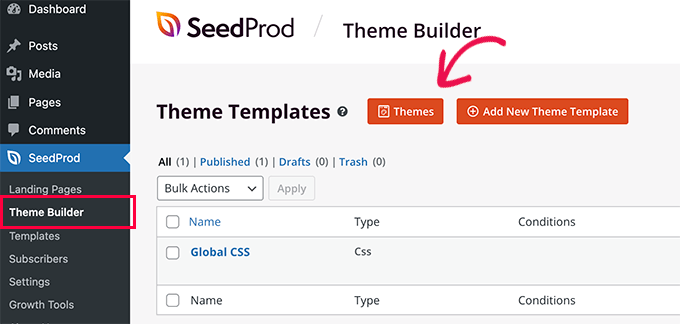
You will now be shown a list of professionally designed themes that are designed for different types of websites.
For example, there are templates called ‘Modern Business’, ‘Marketing Agency’, and ‘Mortgage Broker Theme’.
Have a look through the options and select one that best matches your needs by clicking the checkmark icon.
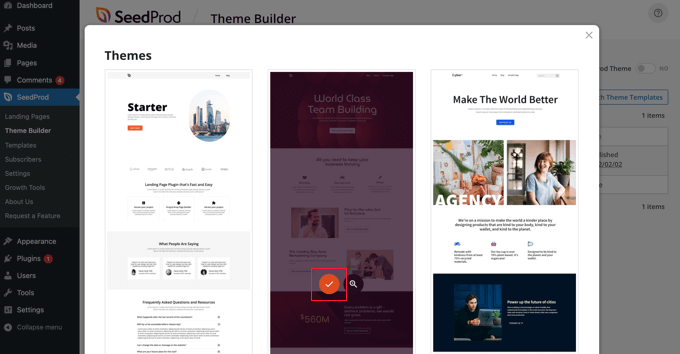
Once you have chosen a theme, SeedProd will generate all the theme templates, including one for your blog index and one for your home page.
These are not just empty pages but come set up with attractive layouts and placeholder content that’s easy to customize.
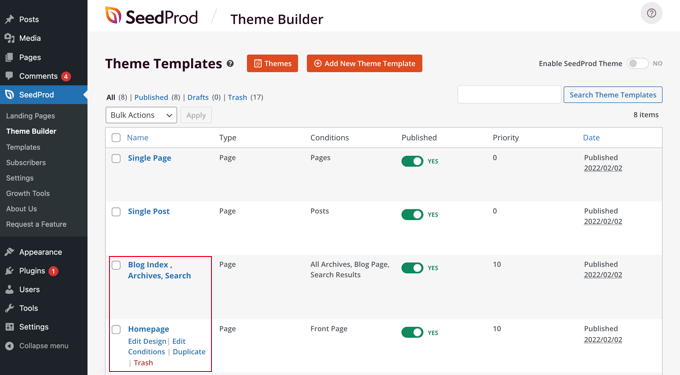
In this tutorial, we will show you how to customize the home page and blog index templates.
You might also like to customize the other templates. To learn how to do that, see our beginner’s guide on how to easily create a custom WordPress theme.
Customizing Your Home Page
Once you have generated your theme templates, you can edit them using the SeedProd theme builder. We will start with the Homepage template.
Simply click the ‘Edit Design’ link under the homepage to get started.

This will launch the template file in the SeedProd theme builder.
This simple drag-and-drop builder will show a live preview of your page to the right and a block toolbar on the left.
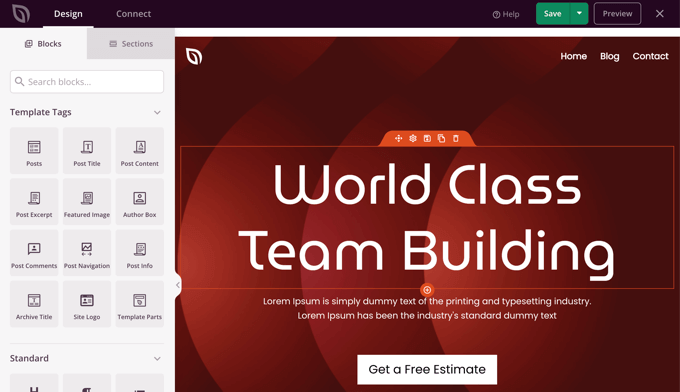
You can customize any block by clicking on it, dragging blocks up and down with your mouse, and adding new blocks to the page.
We’ve written a complete guide on how to create a custom home page in WordPress. Simply scroll down to Method 2 to learn how to customize your home page using SeedProd.
Customizing Your Blog Page
The SeedProd theme builder also provides plenty of ways to customize your blog index page.
Get started by clicking the ‘Edit Design’ link under the page.

You will see the same preview pane on the right and the toolbar on the left. You can customize the blog page the same way you did with the home page.
For example, when you click on the headline, you will be able to see all of its settings. You can edit the text, change the alignment and font size, and more.
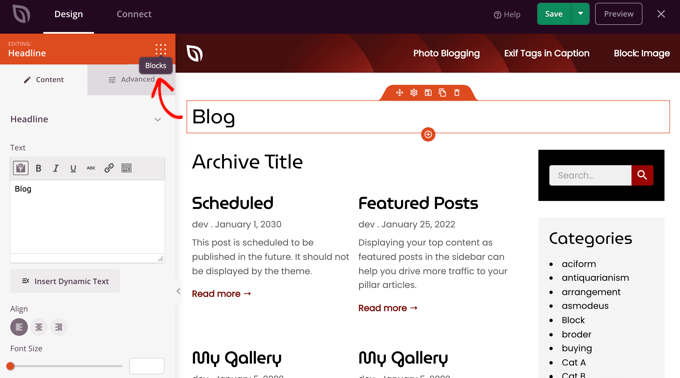
Once you’ve finished, you’ll need to click on the ‘Blocks’ icon to return to the toolbar.
The SeedProd theme builder offers additional Template Parts blocks, such as a Posts block, which displays a list of your blog posts.
The Posts block has already been added to the blog index template for you, and in this template, the block displays your posts in two columns. We can change this to a single column.
Simply click on the Posts block and then change the ‘Columns’ setting to 1.
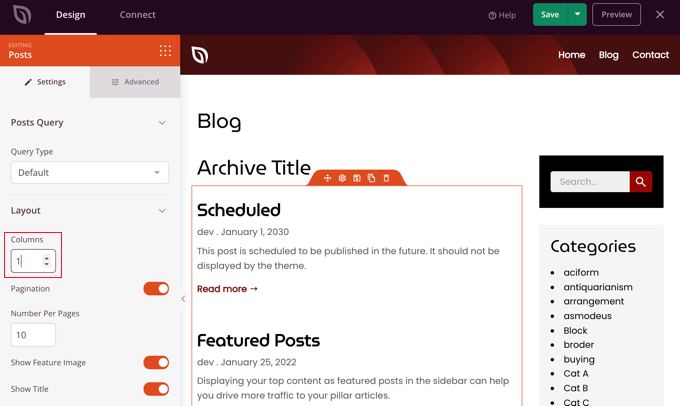
The layout will immediately change to a single column.
As you scroll down the Posts block settings, you’ll find toggle switches that let you choose whether or not to display the post’s feature image and title. You can also choose which header tag to use for the post title.
There are also options for displaying different post metadata. You can toggle the date modified, author, date and time published, and the comment count.
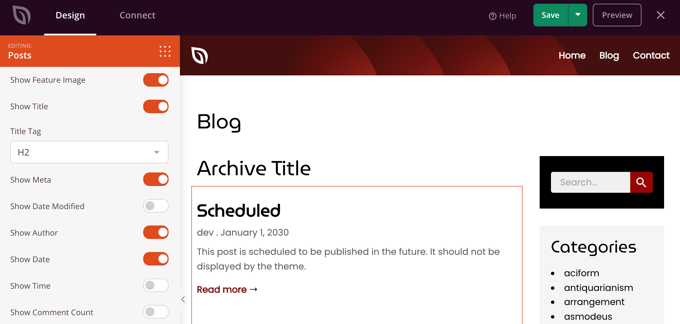
Here are a few more ways that you can customize your blog index:
- You can filter the index by post type, category, tag, or author.
- The sort order of the posts can be changed.
- You can choose how many posts are displayed on a page.
- You can toggle the post excerpt and customize its length.
Once you have finished customizing your blog page, make sure you click the ‘Save’ button at the top of the screen. Then, you can return to the list of templates by clicking the ‘X’ icon.
Enabling the SeedProd Theme
Once you have finished customizing the theme templates, you will need to publish the new custom theme.
Simply toggle the ‘Enable SeedProd Theme’ setting to the ‘YES’ position.
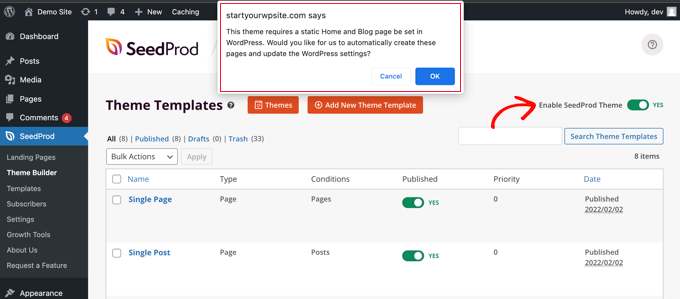
You will immediately see a notification that the WordPress Home and Blog page settings need to be changed. When you click the ‘OK’ button, these settings will be changed for you.
You can now visit your website to view your new home page and blog page. This is how the blog index page looks on our demo site.
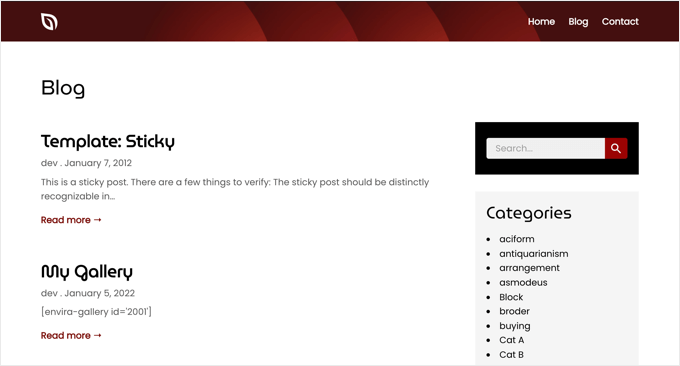
Bonus: Display Your Recent Posts in WordPress
Once you have created a separate blog page, you can still show some recent posts on your home page to encourage users to explore more of your site.
To do this, open your homepage in the WordPress block editor. Once you are there, click the ‘Add Block’ button at the top left corner of the screen to open the block menu.
From here, simply add the ‘Latest Posts’ block to the page. Once you do that, you can customize the list of recent posts to display post excerpts, author names, and dates according to your liking.
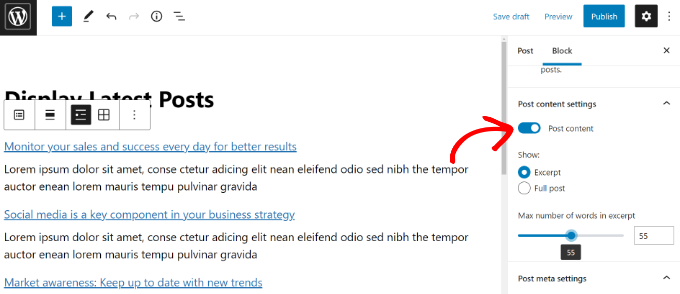
Finally, click the ‘Publish’ button at the top to store your settings. Now, some of your recent posts will still be displayed on the home page to ensure that users spend more time on your website.
For more information, you can see our tutorial on how to display recent posts in WordPress.
We hope this tutorial helped you learn how to create a separate page for blog posts in WordPress. You may also want to learn how to add custom post status for blog posts in WordPress or check out our list of the best related posts plugins for WordPress.
If you liked this article, then please subscribe to our YouTube Channel for WordPress video tutorials. You can also find us on Twitter and Facebook.





Maria
HELP PLEASE: I have created a BLOG PAGE using PAGES. I have added it to the navigational menu and set it as blog on the page attributes.
I have written a post but this does not appear on the blog page. Any suggestions on what I am doing wrong. I have the latest Wordpress update using a MacBook pro.
Thanks
Stephanie
I have successfully created a Home page and Blog page showing the latest posts i.e. 10, is there any way to show more or at least get to the Archive of posts; even by increasing the number this does not seem to change. Thanks.
andrea
Hi i followed this makes lots of sense. Prob is under my MENU creation page and this page you direct us too. I do not see the BLOG page or Home page i created!! Its so frustrating and my web designer wont help me. Any reason why wordpress wont show all the pages or posts i make?
pls help
geetha
Hi
I have a wordpress page.the menu are Home, Blog, About me and Contact.
I am trying to add another page like the “Blog” – obviously under another title, where i can have different topics/ headings. I am currently using a free wordpress.
Bascially i want more blog posts so i can classify my writing under one wordpress site.
Please help.
Kind regards,
Geetha.
Lauren
Very helpful, exactly what I was looking for!
MFH
Thanks, is there any way to add additional design features to the blog page? I’m using a divi child theme and set up a blog page but all design elements are wiped out when I designate the page as the blog page, only the basic primary header and posts show.
Nick tann
I see how this adds a blog page but do I add multiple blog posts to the same page? Is that how it works? Is there a way I can emulate a blog type site on one of my pages like a running diary?
WPBeginner Support
Hi Nick,
No, you would create your blog posts just like you would normally do and they will automatically appear on this page. Yes, it will allow you to keep your blog posts on a separate page like a running diary.
Admin
Bob
This was very helpful. Thank you. bob
kalpana
Thanks for the content…was very useful to me
mahbub
Thank u so much
Melissa
Thank you!
Antony Ramirez Ferrigno
That was very well explained for a total beginner like me!
Cheers
Asumpta
This was incredibly helpful to me especially as a beginner. Thank you
Chris
I followed your video and adjusted my permalink to /blog/%postname%/ and everything works fine when I click on each posts, but I have 10 pages of posts and when I click on the next page on the very bottom of my blog to view my next set of posts I get 404 error page not found.
It returns my permalink as my domain.com/blog/page/2/ which is a 404 error how do I fix this?
How do I fix this so I can see the next pages of posts?
Bo
If you have published posts before adding your blog page, you will need to do a 301 redirect on all the older posts to redirect them to the new ‘blog’ path.
Adnan sami
Thank You Very Much For this kind of help.. it works fine with my blogs and online businesses
WPBeginner Support
You are welcome
Admin
Emma Pacecca
Hi!
I understand how to make the separate page for blog posts, but I am wondering if I can make multiple pages for blog posts in different categories – so I can add travel related blogs to the travel page, lifestyle to the lifestyle page, etc. ?
Any help would be much appreciated!
Thank you!
WPBeginner Support
Please take a look at how to add topics in WordPress navigation menu
Admin
geetha
Hi
Do let me know if you have sorted this out please. Need the same help.
JANITA
You’ve just saved me HOURS. Thank you!
UT
Hi,
I have created a blog page on my website but it does not seem to be updating with the posts I’m putting on there. In addition I need the blog link to go to a separate webpage and not be part of the main website page. Is that possible?
Thanks
UT
Hi,
I created the blog page but when I’ve put in posts it’s not showing in the blog page. Additionally while I have the blog page link on my main front page menu, when I click on the page, I want it to go separately and not be part of the main page theme. Is that possible?
My website is
Thx
Lauri Rottmayer
Thank you so much! So easy but it was totally eluding me.
Valerie
@wpbeginner You have saved the day! I have had an issue with this for months and thought I was smart enough to figure it out but was struggling! This helped fix the issue and although it was still easy, I would have never known how to navigate without this article. Thank you!
WPBeginner Support
Hey Valerie, glad you found it useful You may also want to subscribe to our YouTube Channel for WordPress video tutorials.
You may also want to subscribe to our YouTube Channel for WordPress video tutorials.
Admin
Kasey
Hello I have created a “Home” page as well as a “Blog Posts” page but I want my posts to show up on y home page as well as my blog posts page. How would I go about doing that?
Mar
Hello
I really can’t seem to find where to go. I can add a new page but then it looks completely different then on your screen? are there other ways to do it?
Karen
Tthank you so much for this video!!! I knew it was a simple thing but couldn’t for the life of me find the right setting. Your a lifesaver!!
WPBeginner Support
You are welcome Don’t forget to subscribe to our YouTube Channel for WordPress video tutorials.
Don’t forget to subscribe to our YouTube Channel for WordPress video tutorials.
Admin
Princess Valera
Hi,
I want to ask something, My WordPress doesn’t have Reading Settings it only have Writing Settings. What can i do? Any help? I hope you’ll answer this.
Thanks!
Alissa
I had this problem too, you have to access the Settings through the Word Press Admin (WP Admin) and there is a Reading option there.
Corey
How do I find the WP Admin? I’m having the same problem.
WPBeginner Support
Hey Corey,
Please see our guide on how to find your WordPress login URL.
Eric A. Flores
Great! This was precisely what I needed to know. Much appreciated to such an extent!
WPBeginner Support
You are welcome, make sure you follow us on Twitter to get more WordPress tips and tricks.
Admin
Brandon
Hi, so, I’ve already made a home page, as well as many other pages. But my question is, I want to post on more than ONE page.. Example, I blog about school AND life and I want themto post on separate pages that I’ve made. How can I do this? Thank you!
WPBeginner Support
WordPress comes with a built-in feature called Categories. It allows you to create posts and file them into different categories. Your homepage may show all your posts. But you will also have category archive pages, where users will be able to see all posts filed under that particular topic. Please see our guide on how to add topics to navigation menus in WordPress
Admin
Anjali Kulkarni
how to what
WPBeginner Support
Hey Anjali,
Edited the comment, thanks for pointing this out
Shashank Naithani
Hello Syed,
I have already done this thing and would like to know after changing my bog post page to news the URL is oming like this http://localhost/wp-yfu/news/
however when I click on the post the URL change to http://localhost/wp-yfu/hello-world/
How can I change the url to http://localhost/wp-yfu/news/hello-world/
WPBeginner Support
You can go to Settings » Permalinks and click on custom structure to add /news/ as a prefix to your blog posts. Like this:
/news/%postname%/
Admin
Toby Akuj
Thanks for this excellent tutorial. The static home page requires a URL distinct from the site URL. How do I make the static home page (www.example.com/home/) actually be the home page (www.example.com)? Does it have to be through a URL redirect, or is there a cleaner way?
WPBeginner Support
Go to Settings > Reading page and then select the page you want to set as your homepage by clicking on the dropdown next to ‘Front Page’ option. Don’t forget to save your changes.
Admin
Chinedu Godwin
How do i create a whole new page,where i get to post stuff and engage people to comments on it,it would be different from my normal Blog homepage… I intend on calling the page “community”…
Rei
@wpbeginner, is it possible to command one page to have one category of blog posts?
Ex. I want my page “day in the life of Rei” to have its own blog posts
WPBeginner Support
All categories in WordPress have their own pages. You can file all posts under “day in the life of Rei” category and then add that category into your navigation menu. See our guide on how to add topics in WordPress navigation menu
Admin
Ron Levis
I’m trying to add a Blog page to my existing site with several pages. I already have a “Home” page. Do I need to create a 2nd “Home” page, i.e. ‘Bog Home’ or something like that? When I tried to publish the new Page for the Blog the link simply took page viewers to my main web site’s home page. Thank you!
WPBeginner Support
By default, WordPress has posts (entries in a blog) and pages. See our guide on difference between posts vs pages.
You can create different static pages. For example, you can create a static page to be used as your home page. You can also create a separate page for blog posts. This blog post page does not have any content of its own. It is simply used to display posts published on your blog.
Admin
Samantha
Hi! thanks for the tutorial, can you also make on Blogger?
Daisy
Hi!
This was really helpful! Thanks!
Just have a quick question…
On my home page I want to show say eg. 6 of my latest posts and then have a parent page with all my posts showing up on it as well, is this possible??
Thanks,
Daisy
Alaa
Hi there
I just created a wordpress blog, and everything is going fine so far except my post that appears on home page don’t link to other pages. for example when i post a blog about beauty i want it to link to the beauty page as well home page but this is not working with me. please help! how do i link each post to related page as well as showing in front page?
thank you
Alaa
WPBeginner Support
You need to file your post into categories or tags Then you can add those topics into your navigation bar. See our guide on how to add topics in WordPress navigation menu.
Admin
Sara
Hi,
I wanted to know if it’s possible to create more than 5 static pages on blog site? I haven’t been able to do so. Is that the maximum number of pages you can put up?
WPBeginner Support
No you can create as many pages as you want.
Admin
Amin
Hi there, I want to show less words in post pages. all the content show in post page and i want to show less.
Please help me !
Christian
This video and explanation is so clear and helpful. But it still doesn’t work with me
I don’t have a template for blog, but I follow every other step carefully.
The result is, when I am on my static frontpage and press the blog button in the upper right menu, the new window that opens up, is all blank, except it says test in the top left corner.
Has anyone tried this, and know how to fix it?
Thanks in advance.
Page is a template - You Need to Make a Post
What appears to be with this is the Page creation is only a template and will not display any text or content you happen to write in the page WYSIWYG editor.
If you post a test “post”, and publish it, that post will appear as a regular excerpt post item on that page.
Publish 2-3 test posts and you will see the posts listed on the blog page. Without any posts at all, you will get a near blank page with something like “not found” and with a search box below it.
Did that help?
Momo
This is not working. I still dont have home page to be my blog and to be seen in the page menu
Raju Ferdiansyah
hello, nice tips.
i would to ask you how to make my url is like this
mydomain.com/tutorial-web/post.html and not mydomain.com/category/tutorial-web/post.html
and if my visitor go to mydomain.com/tutorial-web/ the will find all post with ‘Tutorial Web’ category at that page
sorry for my bad english
Thanks for your tutorial, your website is amazing for beginner like me
WPBeginner Support
You may want to take a look at our guide about using SEO friendly url structure in WordPress.
Admin
Katy Pollard
Searched everywhere for this and you finally answered it for me! Thanks!
Nick
Perfect! This was exactly what I wanted to know. Thanks so much!
WPBeginner Support
Glad you found it helpful.
Admin
Maarten
Same thing here! Exactly my problem! Very helpful indeed.
Roderick Stirling
Nice! Thanks.
Raymond
Hi! I would like to know how to make an “overview” of all the blogs you have posted? Please help me out
Pradeep Sahoo
the blog page is going to the main page means home page.
why i don’t know, any suggestion??
Vikram Chouhan
its work really nice, thanks
Muhammad Ali Pasha
The video was really helpful, i am stuck in one more problem ahead of it, its that all the posts do appear in blog page of mine but their permalink is not showing the page name BLOG in it, it’s like
website.com/postname and not
website.com/blog/postname… can you please help me in this regard ?
WPBeginner Support
you can edit permalinks by visiting Settings » Permalinks page. There you can check the custom structure checkbox and use /blog/%postname%/ as your permalink structure. Please note that it will change all your WordPress URLs, this could be bad for SEO.
Admin
tirza
Oh my Gosh thank you!!!!!! Eventually I’ll be able to post the volg about me being able to finally make A PAGE, YES, YES, YES
Patch Welling
I’m a novice to WP and your tutorial is the most helpful I have found so far in rebuilding my website. Thank you.
WPBeginner Support
Glad you found it helpful.
Admin
jayps
Hi, Im new with word press. I did this exactly and was finished customizing my home page. When I was to customize my Post page, I cannot see the “Template” and its corresponding drop down in the “Page attributes.”
Is this because of the theme? Is there any way that I can create a template for my Post page so I can customize the page where my blogs will be posted?
Thanks
Dana
@wpbeginner – Awesome tutorial, very helpful. Now I would like to seek your wise council regarding an issue: I made a seperate news/blog page and it’s all working fine. On my full-width homepage I display a bit of all my pages (services, about us, contact etc). But HOW do I feed the posts from the news section back tot the homepage (I have 4 blocks with only the title and h1 of the news article)?
Thanks!